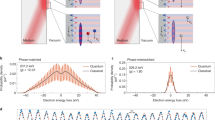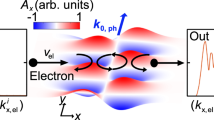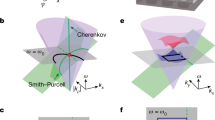Abstract
Free-electron radiation such as Cerenkov1, Smith–Purcell2 and transition radiation3,4 can be greatly affected by structured optical environments, as has been demonstrated in a variety of polaritonic5,6, photonic-crystal7 and metamaterial8,9,10 systems. However, the amount of radiation that can ultimately be extracted from free electrons near an arbitrary material structure has remained elusive. Here we derive a fundamental upper limit to the spontaneous photon emission and energy loss of free electrons, regardless of geometry, which illuminates the effects of material properties and electron velocities. We obtain experimental evidence for our theory with quantitative measurements of Smith–Purcell radiation. Our framework allows us to make two predictions. One is a new regime of radiation operation—at subwavelength separations, slower (non-relativistic) electrons can achieve stronger radiation than fast (relativistic) electrons. The other is a divergence of the emission probability in the limit of lossless materials. We further reveal that such divergences can be approached by coupling free electrons to photonic bound states in the continuum11,12,13. Our findings suggest that compact and efficient free-electron radiation sources from microwaves to the soft X-ray regime may be achievable without requiring ultrahigh accelerating voltages.
This is a preview of subscription content, access via your institution
Access options
Access Nature and 54 other Nature Portfolio journals
Get Nature+, our best-value online-access subscription
$29.99 / 30 days
cancel any time
Subscribe to this journal
Receive 12 print issues and online access
$209.00 per year
only $17.42 per issue
Buy this article
- Purchase on Springer Link
- Instant access to full article PDF
Prices may be subject to local taxes which are calculated during checkout




Similar content being viewed by others
Change history
23 July 2018
In the version of this Letter originally published, an older version of the Supplementary Information was uploaded by mistake, in which the notation did not match the main text. This has been corrected.
References
Cherenkov, P. A. Visible glow under exposure of gamma radiation. Dokl. Akad. Nauk SSSR 2, 451–454 (1934).
Smith, S. J. & Purcell, E. Visible light from localized surface charges moving across a grating. Phys. Rev. 92, 1069 (1953).
Ginsburg, V. & Frank, I. Radiation of a uniformly moving electron due to its transition from one medium into another. Zh. Eksp. Teor. Fiz. 16, 15–28 (1946).
Goldsmith, P. & Jelley, J. Optical transition radiation from protons entering metal surfaces. Philos. Mag. 4, 836–844 (1959).
Liu, S. et al. Surface polariton Cherenkov light radiation source. Phys. Rev. Lett. 109, 153902 (2012).
Kaminer, I. et al. Efficient plasmonic emission by the quantum Čerenkov effect from hot carriers in graphene. Nat. Commun. 7, ncomms11880 (2016).
Luo, C., Ibanescu, M., Johnson, S. G. & Joannopoulos, J. Cerenkov radiation in photonic crystals. Science 299, 368–371 (2003).
Adamo, G. et al. Light well: a tunable free-electron light source on a chip. Phys. Rev. Lett. 103, 113901 (2009).
Ginis, V., Danckaert, J., Veretennicoff, I. & Tassin, P. Controlling Cherenkov radiation with transformation-optical metamaterials. Phys. Rev. Lett. 113, 167402 (2014).
Liu, F. et al. Integrated Cherenkov radiation emitter eliminating the electron velocity threshold. Nat. Photon. 11, 289–292 (2017).
Hsu, C. W. et al. Observation of trapped light within the radiation continuum. Nature 499, 188–191, (2013).
Yang, Y., Peng, C., Liang, Y., Li, Z. & Noda, S. Analytical perspective for bound states in the continuum in photonic crystal slabs. Phys. Rev. Lett. 113, 037401 (2014).
Hsu, C. W., Zhen, B., Stone, A. D., Joannopoulos, J. D. & Soljacic, M. Bound states in the continuum. Nat. Rev. Mater. 1, 16048 (2016).
Urata, J. et al. Superradiant Smith–Purcell emission. Phys. Rev. Lett. 80, 516–519 (1998).
Korbly, S., Kesar, A., Sirigiri, J. & Temkin, R. Observation of frequency-locked coherent terahertz Smith-Purcell radiation. Phys. Rev. Lett. 94, 054803 (2005).
Doucas, G., Mulvey, J., Omori, M., Walsh, J. & Kimmitt, M. First observation of Smith-Purcell radiation from relativistic electrons. Phys. Rev. Lett. 69, 1761–1764 (1992).
Kube, G. et al. Observation of optical Smith-Purcell radiation at an electron beam energy of 855 MeV. Phys. Rev. E 65, 056501 (2002).
Yamamoto, N., de Abajo, F. J. G. & Myroshnychenko, V. Interference of surface plasmons and Smith-Purcell emission probed by angle-resolved cathodoluminescence spectroscopy. Phys. Rev. B 91, 125144 (2015).
Kaminer, I. et al. Spectrally and spatially resolved Smith-Purcell radiation in plasmonic crystals with short-range disorder. Phys. Rev. X 7, 011003 (2017).
Moran, M. J. X-ray generation by the Smith-Purcell effect. Phys. Rev. Lett. 69, 2523–2526 (1992).
van den Berg, P. Smith-Purcell radiation from a point charge moving parallel to a reflection grating. J. Opt. Soc. Am. 63, 1588–1597 (1973).
Haeberlé, O., Rullhusen, P., Salomé, J.-M. & Maene, N. Calculations of Smith-Purcell radiation generated by electrons of 1–100 MeV. Phys. Rev. E 49, 3340–3352 (1994).
Sergeeva, D. Y., Tishchenko, A. & Strikhanov, M. Conical diffraction effect in optical and x-ray Smith-Purcell radiation. Phys. Rev. ST Accel. Beams 18, 052801 (2015).
Pendry, J. & Martin-Moreno, L. Energy loss by charged particles in complex media. Phys. Rev. B 50, 5062–5073 (1994).
García de Abajo, F. J. Smith-Purcell radiation emission in aligned nanoparticles. Phys. Rev. E 61, 5743–5752 (2000).
García de Abajo, F. J. Optical excitations in electron microscopy. Rev. Mod. Phys. 82, 209–275 (2010).
Miller, O. D. et al. Fundamental limits to optical response in absorptive systems. Opt. Express 24, 3329–3364 (2016).
Yang, Y., Miller, O. D., Christensen, T., Joannopoulos, J. D. & Soljačić, M. Low-loss plasmonic dielectric nanoresonators. Nano Lett. 17, 3238–3245 (2017).
Miller, O. D., Johnson, S. G. & Rodriguez, A. W. Shape-independent limits to near-field radiative heat transfer. Phys. Rev. Lett. 115, 204302 (2015).
Friedman, A., Gover, A., Kurizki, G., Ruschin, S. & Yariv, A. Spontaneous and stimulated emission from quasifree electrons. Rev. Mod. Phys. 60, 471–535 (1988).
Massuda, A. et al. Preprint at https://arxiv.org/abs/1710.05358 (2017).
Gradshteyn, I. S. & Ryzhik, I. M. in Tables of Integrals, Series, and Products 6th edn (eds Jeffrey, A. & Zwillinger, D.) 843–850 and 1022–1025 (Academic, San Diego, CA, 2000).
Pendry, J., Martin-Moreno, L. & Garcia-Vidal, F. Mimicking surface plasmons with structured surfaces. Science 305, 847–848 (2004).
Andrews, H. L. & Brau, C. A. Gain of a Smith-Purcell free-electron laser. Phys. Rev. ST Accel. Beams 7, 070701 (2004).
Kumar, V. & Kim, K.-J. Analysis of Smith-Purcell free-electron lasers. Phys. Rev. E 73, 026501 (2006).
Green, M. A. Self-consistent optical parameters of intrinsic silicon at 300 K including temperature coefficients. Sol. Energy Mater. Sol. Cells 92, 1305–1310 (2008).
Schächter, L. & Ron, A. Smith-Purcell free-electron laser. Phys. Rev. A 40, 876–896 (1989).
Peralta, E. A. et al. Demonstration of electron acceleration in a laser-driven dielectric microstructure. Nature 503, 91–94 (2013).
Breuer, J. & Hommelhoff, P. Laser-based acceleration of nonrelativistic electrons at a dielectric structure. Phys. Rev. Lett. 111, 134803 (2013).
Palik, E. D. Handbook of Optical Constants of Solids Vol. 3 (Academic, San Diego, CA, 1998).
Acknowledgements
The authors acknowledge fruitful discussions with K. Berggren, S. Yang, C. Peng, A. Gover, B. Zhen, L. J. Wong, X. Lin, D. Zhu, Yu. Yang, T. Dubcek and N. Rivera. We thank P. Rebusco for critical reading and editing of the manuscript. This work was performed in part at the Harvard University Center for Nanoscale Systems (CNS), a member of the National Nanotechnology Coordinated Infrastructure Network (NNCI), which is supported by the National Science Foundation under NSF ECCS award no. 1541959. This work was partly supported by the Army Research Office through the Institute for Soldier Nanotechnologies under contract nos W911NF-18-2-0048 and W911NF-13-D-0001. Y.Y. was partly supported by the MRSEC Program of the National Science Foundation under grant no. DMR-1419807. T.C. was supported by the Danish Council for Independent Research (grant no. DFFC6108-00667). O.D.M. was supported by the Air Force Office of Scientific Research under award no. FA9550-17-1-0093. I.K. was partially supported by the Azrieli foundation and the Seventh Framework Programme of the European Research Council (FP7- Marie Curie IOF) under grant agreement no. 328853CMC-BSiCS.
Author information
Authors and Affiliations
Contributions
Y.Y., O.D.M., I.K. and M.S. conceived the project. Y.Y. developed the analytical models and numerical calculations. A.M. prepared the sample under study. Y.Y., A.M., C.R.-C., S.E.K. and I.K. performed the experiment. Y.Y., T.C. and O.D.M. analysed the asymptotics and bulk loss of the limit. S.G.J., J.D.J., O.D.M., I.K. and M.S. supervised the project. Y.Y. wrote the manuscript with input from all authors.
Corresponding authors
Ethics declarations
Competing interests
The authors declare no competing interests.
Additional information
Publisher’s note: Springer Nature remains neutral with regard to jurisdictional claims in published maps and institutional affiliations.
Supplementary information
Supplementary Information
10 Figure, 12 References
Rights and permissions
About this article
Cite this article
Yang, Y., Massuda, A., Roques-Carmes, C. et al. Maximal spontaneous photon emission and energy loss from free electrons. Nature Phys 14, 894–899 (2018). https://doi.org/10.1038/s41567-018-0180-2
Received:
Accepted:
Published:
Issue Date:
DOI: https://doi.org/10.1038/s41567-018-0180-2
This article is cited by
-
Free-electron crystals for enhanced X-ray radiation
Light: Science & Applications (2024)
-
Robust asymmetric Cherenkov radiation in tilted anisotropic medium
Science China Physics, Mechanics & Astronomy (2024)
-
How to light up the electron microscope
Nature Physics (2023)
-
Quantum recoil in free-electron interactions with atomic lattices
Nature Photonics (2023)
-
Applications of bound states in the continuum in photonics
Nature Reviews Physics (2023)



